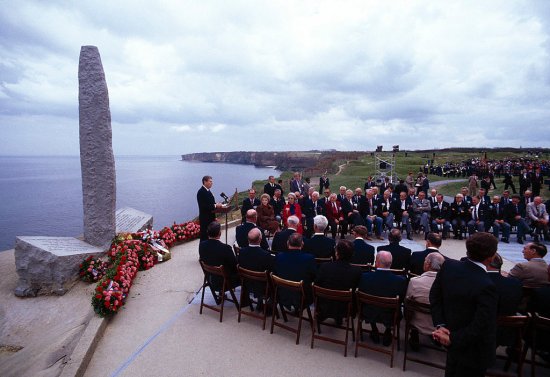
Forty years ago, Ronald Reagan used the same anniversary to boost his image as a statesman.
Today, President Joe Biden gives remarks at the 80th anniversary of D-Day in Normandy to honor past military sacrifices and triumphs. But with an eye toward the 2024 presidential race, he is also following a well-worn playbook of leveraging international travel to win domestic political points.
Indeed, his Republican predecessor, Ronald Reagan, used the exact same anniversary 40 years ago to deliver one of his most famous overseas speeches, as a part of a carefully choreographed ten-day tour of Europe. The tour was designed to showcase Reagan, a strong orator, at his most “presidential” in a bid to boost his re-election chances while upstaging his Democratic rivals. Reagan’s ability to master what CBS reporter Lesley Stahl observed as “political one-upmanship”—as he confidently performed his role of head of state abroad, while remaining above the political fray at home—stands as a model for the Biden Administration today, as he too aims to bolster his re-election campaign.
[time-brightcove not-tgx=”true”]Reagan toured Europe from June 1-10, 1984, with a stated goal of strengthening U.S.-European relations. But Reagan’s team planned his visit with its domestic impact firmly in mind. This high-profile overseas trip created a platform from which Reagan could highlight some of the key achievements of his first term and present his views on issues that were critical to voters, without formally campaigning. He was polling poorly at the time, with Gallup showing that just 37% of Americans supported his foreign policy. His management of the economy was also the subject of much debate. Furthermore, Reagan’s earlier trip to Europe was branded as “stumbling and overscheduled,” so a second tour offered a chance to improve public perceptions of his capabilities as a statesman.
The tour began in Ireland, and with 40 million Americans of Irish ancestry (including Reagan), it was no secret that his campaign sought their support in the upcoming election. Although Reagan was not Catholic, the Administration clearly believed that a trip to Ireland would impress the crucial bloc of Catholic voters (many of them former Democrats) that had helped elect him in 1980. In a memo outlining the potential domestic impact of the visit, former diplomat Thomas Patrick Melady stated that “the two important factors in the domestic equation are Irish and Catholic.” In a bid for these all-important “Reagan Democrats,” as the press had dubbed them, Melady even proposed inviting a delegation of journalists from Catholic newspapers to participate in this leg of the journey.
Reagan’s next stop was Normandy, where his high-profile attendance at the 40th anniversary D-Day memorial service allowed the White House to showcase his oratory skills and demonstrate his ability to be dignified and statesmanlike on the world stage.
Read More: Ronald Reagan’s Playbook Can Offer Biden a Lesson on Iran
Reagan’s aides deliberately timed the delivery of his Normandy address to capitalize on NBC, CBS, and ABC’s interest in the anniversary, moving the timing to 7 a.m. EST in an effort to upstage the results of the previous night’s Democratic primaries (including the all-important primary election in California) on American morning news programs. Peggy Noonan, one of Reagan’s speechwriters, studied photographs of the location where Reagan would speak to tailor his comments according to what television viewers would see as he gave his speech. Footage of Reagan’s Normandy address was later shown at the Republican National Convention in prime time, reinforcing its importance for the campaign.
Reagan’s last stop was London, where he attended the G7 Summit. Once again, his aides planned for this Summit to bolster his re-election bid. The U.K. Ambassador in Washington, D.C., Oliver Wright, sent key telegrams to the Foreign and Commonwealth Office to assist in planning the G7, one of which stated: “What the president wants above all from his visit to London is an outcome that will play well in his election campaign. His staff tell us that he will want to look ‘presidential.’” Indeed, Washington Post journalist Lou Cannon reported that on one occasion three members of the print press corps were asked to leave the room, to allow space for the Republican National Committee’s film cameras to gather footage for Reagan’s campaign advertising material. Such overt political calculations did not deter the message, according to Cannon, who boldly declared upon Reagan’s return to American soil that “no president since John F. Kennedy has performed as successfully on the world stage.”
So, how successful was this strategy? Despite the sustained and broadly positive media coverage this trip secured, Reagan’s approval ratings did not increase between the start and end of the trip, nor were there any notable shifts in opinion polls on key policy decisions. However, Reagan established a media narrative that became central to his campaign, all while avoiding financing the trip, and the staged photo opportunities, from his campaign budget.

In short, the president used his dual status as head of state and elected politician to his fullest political advantage when embarking on his program of pre-election travels. His landslide election victory later that year suggests that no challenger stood a chance against an incumbent who so clearly thrived in his role as the “Great Communicator.”
Sarah Thomson holds a Ph.D. in 20th century U.S. political history from the University of Edinburgh. She now works as a curator at the National Library of Scotland, and also as a freelance historical writer. Her freelance work has previously appeared in History Today, The Washington Post and Atlas Obscura.
Made by History takes readers beyond the headlines with articles written and edited by professional historians. Learn more about Made by History at TIME here. Opinions expressed do not necessarily reflect the views of TIME editors.